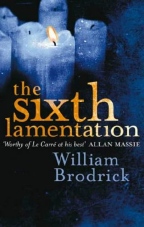The Sixth Lamentation
William Brodrick
Time Warner Paperbacks
UK mass Market Paperback
ISBN 0-7515-3581-8
Publication Date: April 2004
Pages: 430; Price: £6.99
Date Reviewed: 17-05-04
Reviewed by: Katie Dean © 2004

REFERENCES
COLUMNS
|
|
|
The Sixth LamentationWilliam BrodrickTime Warner PaperbacksUK mass Market PaperbackISBN 0-7515-3581-8Publication Date: April 2004Pages: 430; Price: £6.99Date Reviewed: 17-05-04Reviewed by: Katie Dean © 2004 |
|
|
REFERENCES |
COLUMNS |
Despite its suggestively science fiction style title, 'The Sixth Lamentation' is actually a novel about the harrowing events that took place in occupied France during the Second World War and the impact they are still having today. The story is essentially a thriller, jumping between the 1940s and the 1990s using a cast of characters spanning three generations. It has so many twists and turns that the reader is kept guessing right up until the last page. As well as being a truly compelling novel, it deals with difficult moral issues in a mature way that leaves plenty to think about. All in all this is a novel that is hard to put down and asks to be read again and again.
Brodrick uses an impressive cast of characters whose relations to one another are helpfully laid out at the front of the book. The action focuses on the lives of three survivors of World War II; a Nazi officer, a French collaborator and a French survivor of the concentration camps. Secondary to these figures, but no less important, are their respective families, the children and grandchildren of the veterans. Finally, a handful of monks complete the cast. This is a large number of characters for an author to portray, but Brodrick manages with seeming ease. We feel that we get to know each one and all are complex individuals that do not conform to the stereotypes one might expect. Brodrick offers terse descriptions that convey precisely what is required and no more. It is a masterly example of the power of understatement.
In the same manner, the horrific events of 1940s Paris are conjured up more by suggestion than through graphic detail. Brodrick offers enough information to sketch a convincing atmosphere, but leaves the rest up to the reader's imagination. This is far more powerful as an evocative tool than pages of minutely detailed action. It also affords the space to deal with what is in fact a very complex story.
The novel begins when a suspected Nazi war criminal, Eduard Schwermann, is publicly exposed in the press. He seeks refuge in a monastery. It quickly becomes apparent that his case is not straightforward. The Church is placed in an awkward position - should they afford him sanctuary and appear to be condoning his alleged crimes, or should they heartlessly hand a seventy-year old over to the police? The story of the capture and trial of this man forms one strand of the novel. The second centers around Agnes, the survivor of Auschwitz. Agnes is dying and has up to this point refused to talk about her experiences during the War. Now, she decides is the time to confide in her granddaughter, Lucy. Coincidentally this decision is taken at precisely the time Schwermann is exposed and Agnes recognizes in him the Nazi officer who sent her to Auschwitz. The story unfolds from both the point of view of the criminal and the victim. Both are linked by another shadowy figure, the Frenchman who collaborated with the Nazis, Victor Brionne. The reader is immediately called upon to sympathise with the victim, who was involved in saving Jewish children from the death camps, and condemn the Nazi officer for killing millions of innocent Jews, aided by a Frenchman who betrayed his countrymen. However, nothing is as straightforward as it at first appears.
This is a novel about truth. It takes a particularly unpleasant chapter of recent history and exposes the moral dilemmas faced by everyone involved. Unlike so many World War II novels and films, it is not about 'good' and 'evil', 'us' and 'them'. It illustrates that life is never black and white. People are not wholly good or wholly evil. Just when it seems that the actions and motivations of one of the characters have been revealed, a strange turn of events illustrates that the answer is not as straightforward as it first appeared. By the end of the novel, the reader has been led through a complex maze of condemnation and forgiveness in which conventional morality has been called into question and accepted truths challenged. This is a brilliant, fast-paced novel whose careful construction deals with highly complex issues in a thought-provoking manner.